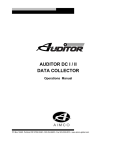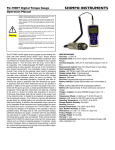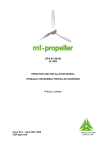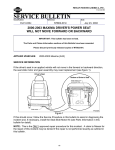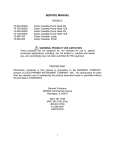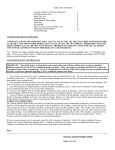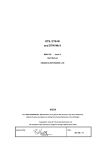Download Overhead Set
Transcript
9/04/09 10:11 AM Overhead Set (003-004) Measure General Information All overhead lash measurements must be made when the engine is cold. Stabilized coolant temperature must be at 60°C [140°F] or below. Remove the rocker lever cover. Make sure the engine base timing is properly set before attempting to measure, adjust, or set the overhead. Early engine vibration dampers are marked with BRAKE SET 1-6, BRAKE SET 2-5, or BRAKE SET 34. The engine brakes must be set at the appropriate mark on these engines. Newer engine vibration dampers are marked with only A, B, or C, and are adjusted with the valves and injector on the same cylinder. Locate the valve set marks on the outside of the vibration damper. Page 1 of 14 9/04/09 10:11 AM The set marks are A, B, and C: Set to mark A to adjust cylinder 1 or 6. Set to mark B to adjust cylinder 2 or 5. Set to mark C to adjust cylinder 3 or 4. Two complete revolutions are required to set all valves, engine brakes, and injectors. If the engine is equipped with an air compressor: Remove the oil fill connector from the lower gear case cover. Insert a 3/4-inch drive ratchet and extension into the air compressor drive. Rotate the air compressor drive clockwise, as viewed from the front of the engine. WARNING Do not pull or pry on the fan to manually rotate the engine. To do so can damage the fan blades. Damaged fan blades can cause premature fan failures which can result in serious personal injury or property damage. The crankshaft rotation is clockwise, as viewed from the front of the engine. The cylinders are numbered from the front of the engine (1-2-3-4-5-6). The engine firing order is 1-5-3-6-2-4. If the engine is not equipped with an air compressor: Loosen the cover plate capscrews and rotate the cover or remove the oil fill tube, if equipped. Page 2 of 14 9/04/09 10:11 AM Use a 1½ inch socket to push the barring gear into the gear mesh and rotate the barring adapter counterclockwise to bar the engine. Rock the barring device back and forth until it disengages. Each cylinder has four rocker levers: The exhaust valve rocker lever (1) The injector rocker lever (2) The intake valve rocker lever (3) The engine brake rocker lever (4). The intake valve rocker lever is always the long lever on the valve rocker lever shaft. Early engine vibration dampers are marked with BRAKE SET 1-6, BRAKE SET 2-5, or BRAKE SET 34. The engine brakes must be set at the appropriate mark on these engines. Newer engine vibration dampers are marked with only A, B, or C, and are adjusted with the valves and injector on the same cylinder. The valves, brakes, and the injectors on the same cylinder are adjusted at the same index mark on the vibration damper. Injector and Valve Adjustment Sequence Bar Engine Set Set Set in Pulley Cylinder Cylinder Cylinder Direction Position Injector Valve Brake of Rotation Start A 1 1 1 Advance to B 5 5 5 Advance to C 3 3 3 Advance to A 6 6 6 Advance to B 2 2 2 Advance to C 4 4 4 Page 3 of 14 9/04/09 10:11 AM Firing Order: 1-53-6-2-4 NOTE: For illustrative purposes, position A is shown as the first step. It is not necessary to start with position A, as long as the proper sequence is followed. Use the compressor drive or barring device to bar the engine over in the direction of engine rotation, clockwise as viewed from the front of the engine. Align the A mark on the vibration damper with the pointer on the gear cover. Check the valve rocker levers on the given cylinder to see if both intake and exhaust valves are closed. Both sets of valves are closed when the rocker levers and the brake lever are loose. If both sets of valves are not closed, rotate the compressor drive gear one complete revolution, and align the A mark on the front damper with the pointer again. Valve Lash Use feeler gauges to measure the amount of clearance (lash) between the crosshead and the rocker lever nose. Measure and record the intake, exhaust, and brake valve lash. If the valve lash is not within the specifications listed below, the valve must be adjusted. See the adjust step in this procedure. Press the brake lever down to verify the camshaft follower is in contact with the camshaft prior to measurement of the brake lash. ISX, QSX Series Valve Lash Recheck Limits Intake 0.23 mm minimum 0.006 in Intake 0.48 mm maximum 0.019 in Exhaust 0.56 mm minimum 0.022 in Exhaust 0.81 mm maximum 0.032 in Brake 6.87 mm minimum 0.271 in Page 4 of 14 9/04/09 10:11 AM Brake 7.13 mm maximum 0.281 in Brake Running Clearance Rotate the brake lever to the detent (neutral) position. Check the clearance between the engine brake actuator piston and the cross head guide pin (1). If the brake running clearance is not within the specifications listed below, the running clearance must be adjusted. See the Adjust step in this procedure. Brake Running Clearance mm 0.635 2.79 MIN MAX in 0.025 0.110 Injector Lash There is no service procedure to check the injector free load. Install the rocker lever cover. Adjust Read the entire procedure for overhead adjustment before attempting to perform this operation. Valves, injectors, and engine brakes (if equipped) must be correctly adjusted for the engine to operate efficiently. Valve, injector, and engine brake adjustment must be performed using the values listed in this section. After an engine rebuild or any major repair where the injector and valve setting must be disturbed, set all of the valves, injectors, and brakes. Valve, Brake, and Injector Adjustment Values Injector Adjustment is 8 N•m [70 in-lb] Intake Valve 0.35 mm [0.014 in] Page 5 of 14 9/04/09 10:11 AM Exhaust Valve 0.68 mm [0.027 in] Engine Brake 7.00 mm [0.276 in] Early engine vibration dampers are marked with BRAKE SET 1-6, BRAKE SET 2-5, or BRAKE SET 34. The engine brakes must be set at the appropriate mark on these engines. Newer engine vibration dampers are marked with only A, B, or C, and are adjusted with the valves and injector on the same cylinder. Locate the valve set marks on the outside of the vibration damper. The set marks are A, B, and C: Set to mark A to adjust cylinder 1 or 6. Set to mark B to adjust cylinder 2 or 5. Set to mark C to adjust cylinder 3 or 4. Two complete revolutions are required to set all valves, engine brakes, and injectors. If the engine is equipped with an air compressor: Remove the oil fill connector from the lower gear case cover. Insert a 3/4-inch drive ratchet and extension into the air compressor drive. Rotate the air compressor drive clockwise, as viewed from the front of the engine. WARNING Do not pull or pry on the fan to manually rotate the engine. To do so can damage the fan blades. Damaged fan blades can cause premature fan failures which can result in serious personal injury or property damage. The crankshaft rotation is clockwise as viewed from the front of the engine. The cylinders are numbered from the front of the Page 6 of 14 9/04/09 10:11 AM engine (1-2-3-4-5-6). The engine firing order is 1-5-3-6-2-4. If the engine is not equipped with an air compressor: Loosen the capscrews and rotate the cover or remove the oil fill tube, if equipped. Use a 1½ inch socket to push the barring gear into the gear mesh and rotate the barring adapter counterclockwise to bar the engine. Rock the barring device back and forth until it disengages. Each cylinder has four rocker levers: The exhaust valve rocker lever (1) The injector rocker lever (2) The intake valve rocker lever (3) The engine brake rocker lever (4). The intake valve rocker lever is always the long lever on the valve rocker lever shaft. Early engine vibration dampers are marked with BRAKE SET 1-6, BRAKE SET 2-5, or BRAKE SET 34. The engine brakes must be set at the appropriate mark on these engines. Newer engine vibration dampers are marked with only A, B, or C, and are adjusted with the valves and injector on the same cylinder. The valves, brakes, and injectors on the same cylinder are adjusted at the same index mark on the vibration damper. Injector Page 7 of 14 9/04/09 10:11 AM and Valve Adjustment Sequence Bar Engine Set Set Set in Pulley Cylinder Cylinder Cylinder Direction Position Injector Valve Brake of Rotation Start A 1 1 1 Advance to B 5 5 5 Advance to C 3 3 3 Advance to A 6 6 6 Advance to B 2 2 2 Advance to C 4 4 4 Firing Order: 1-53-6-2-4 NOTE: For illustrative purposes, position A is shown as the first step. It is not necessary to start with position A, as long as the proper sequence is followed. Use the compressor drive or barring device to bar the engine over in the direction of engine rotation, clockwise as viewed from the front of the engine. Align the A mark on the vibration damper with the pointer on the gear cover. Check the valve rocker levers on the given cylinder to see if both intake and exhaust valves are closed. Both sets of valves are closed when the rocker levers and the brake lever are loose. If both sets of valves are not closed, rotate the compressor drive gear one complete revolution, and align the A mark on the front damper with the pointer again. Loosen the injector adjusting screw locknut on the cylinder. Do not use a click-type torque wrench. Page 8 of 14 9/04/09 10:11 AM Use a dial-type torque wrench with a range of 0 to 150 in-lb to tighten the injector rocker lever adjusting screw. If the screw chatters during setting, repair the screw and lever as required. Back out the adjusting screw one or two turns. Hold the torque wrench in a position that allows you to look in a direct line at the dial. This is to make sure the dial will be read accurately. Make sure the parts are aligned, and squeeze the oil out of the valve and injector train by tightening the adjusting screw. Use this initial adjustment to preload the valve train and injector. Tighten the injector lever adjusting screw. Torque Value: 8 n.m [71 in-lb ] Back the adjusting lever screw out 1 or 2 turns. Tighten the injector lever adjusting screw. Torque Value: 8 n.m [71 in-lb ] Hold the injector lever adjusting screw and tighten the adjusting screw locknut. Torque Value: 75 n.m [55 ft-lb ] After setting the injector on a cylinder, set the valves and engine brakes on the same cylinder. Early engine vibration dampers are marked with BRAKE SET 1-6, BRAKE SET 2-5, or BRAKE SET 34. The engine brakes must be set at the appropriate mark on these engines. Newer engine vibration Page 9 of 14 9/04/09 10:11 AM dampers are marked with only A, B, or C, and are adjusted with the valve and injector on the same cylinder. With the set mark aligned with the pointer on the gear cover and both sets of valves closed on the cylinder, loosen the locknuts on the intake and exhaust valve adjusting screws. Back out the adjusting screws one or two turns. Select a feeler gauge for the correct valve lash specification. Intake Exhaust Valve Lash Specification mm 0.36 NOM 0.69 NOM in 0.014 0.027 Insert the feeler gauge between the top of the crosshead and the rocker lever nose pad. Make sure the feeler gauge is completely under the pivoting rocker lever nose pad. Tighten the adjusting screw. Torque Value: 0.6 n.m [5 in-lb ] Page 10 of 14 9/04/09 10:11 AM Use a torque wrench and crows foot adapter to tighten the locknut. Hold the adjusting screw in this position. The adjusting screw must not turn when the locknut is tightened. Torque Value: 45 n.m [33 ft-lb ] After tightening the locknut to the correct torque value, remove the feeler gauge. CAUTION To get maximum brake operating efficiency and to prevent engine damage, the brake adjustment instructions must be followed. For older engines, locate the engine brake set marks on the outside of the vibration damper. The set marks are BRAKE SET 1-6, and BRAKE SET 2-5, and BRAKE SET 3-4. BRAKE SET 1-6: Cylinder 1 or 6 adjust BRAKE SET 2-5: Cylinder 2 or 5 adjust BRAKE SET 3-4: Cylinder 3 or 4 adjust Page 11 of 14 9/04/09 10:11 AM Use the compressor drive or barring device to bar the engine over in the direction of rotation, clockwise as viewed from the front of the engine. Align the A mark on the vibration damper with the pointer on the gear cover. For illustrative purposes, position A is shown as the first step. It is not necessary to start with position A, as long as the proper sequence is followed. Check the valve rocker levers on the given cylinder to see if both intake and exhaust valves are closed. Both sets of valves are closed when the rocker levers and the brake lever are loose. If both sets of valves are not closed, rotate the compressor drive gear one complete revolution, and align the A mark on the front damper with the pointer again. Press the engine brake lever down to verify the camshaft follower is in contact with the camshaft. Loosen the locknut on the brake lever adjusting screw, and back out the adjusting screw one turn. Insert the feeler gauge, Part Number 3163530, between the bottom of the engine brake piston and the top of the exhaust valve pin on the exhaust valve crosshead. Brake Lever Lash Specification mm in 7.00 NOM 0.276 Tighten the adjusting screw until drag on the feeler Page 12 of 14 9/04/09 10:11 AM gauge is felt. Proper drag means that there is no motion of the brake lever camshaft follower against the cam lobe. Hold the engine brake lever adjusting screw and tighten the locknut. Torque Value: 20 n.m [177 inlb ] Remove the feeler gauge. CAUTION Engine damage can occur if the running clearance is not within specifications. Check the running clearance: 0. Rotate the engine brake rocker lever to the detente (neutral) position. 1. Check the clearance (1) between the engine brake lever actuator piston and the crosshead guide pin. Engine Brake Rocker Lever Running Clearance mm in 0.635 MIN 0.025 2.790 MAX 0.110 If the running clearance does not meet specification, loosen, but do not remove the rocker shaft capscrews, and rotate the shaft in the direction required to bring the running clearance within the listed specification. It is critical that this clearance be set and verified on all six brake levers. Engine damage can result if this task is not completed. Check the brake running clearance. Page 13 of 14 9/04/09 10:11 AM The rocker lever shafts must be adjusted so that all three engine brake levers fall within the given running clearance specification. Repeat the process to adjust all injectors, engine brakes, and valves according to the chart shown below. Injector and Valve Adjustment Sequence Bar Engine Set Set Set in Pulley Cylinder Cylinder Cylinder Direction Position Injector Valve Brake of Rotation Start A 1 1 1 Advance to B 5 5 5 Advance to C 3 3 3 Advance to A 6 6 6 Advance to B 2 2 2 Advance to C 4 4 4 Firing Order: 1-53-6-2-4 Last Modified: 28-Apr-2008 Page 14 of 14














